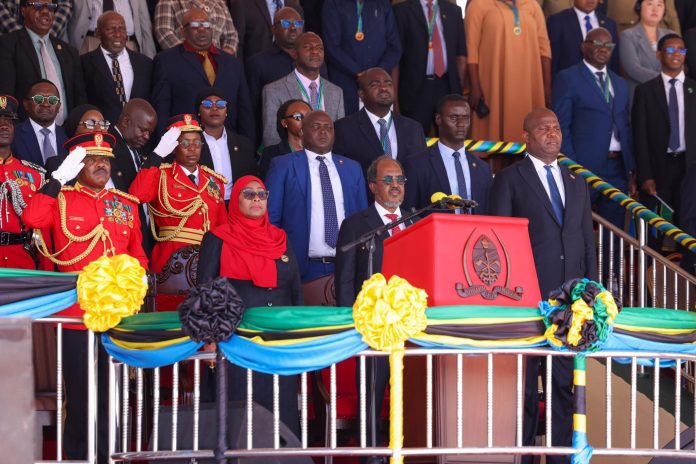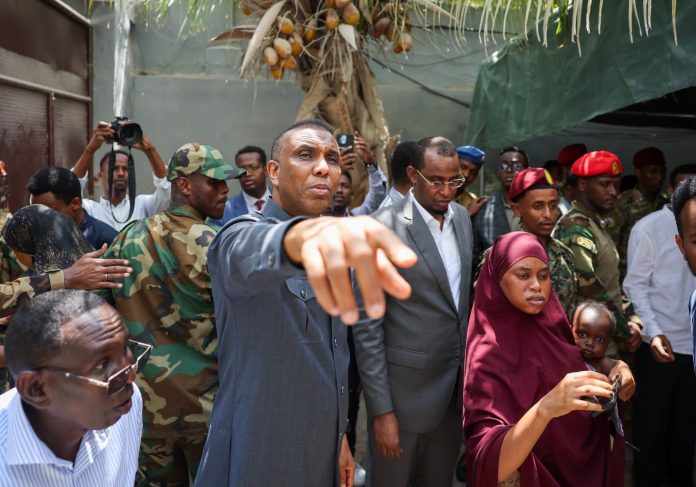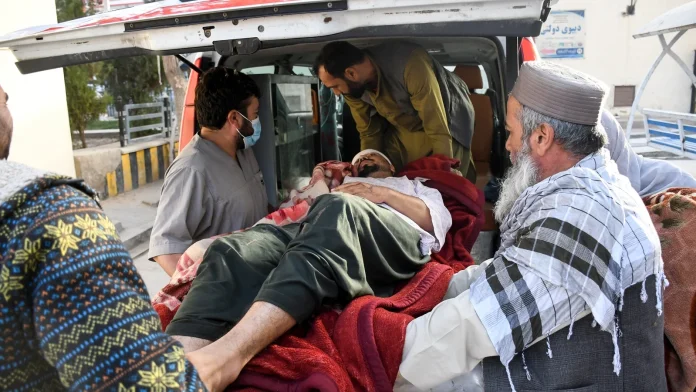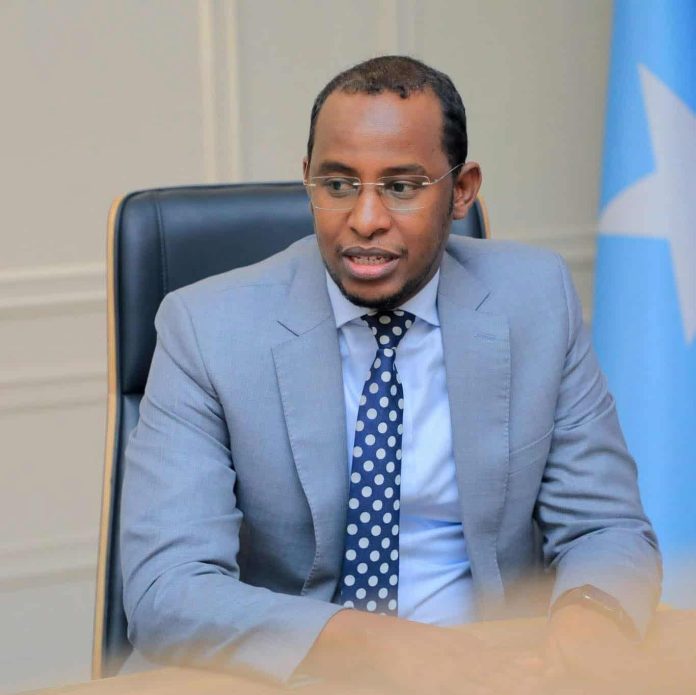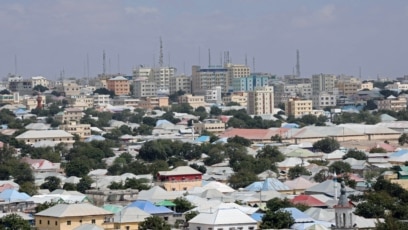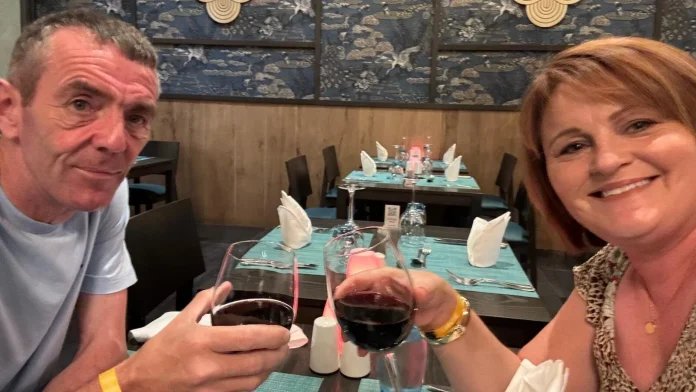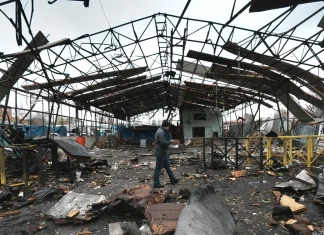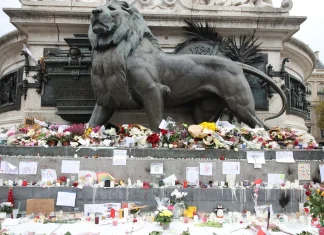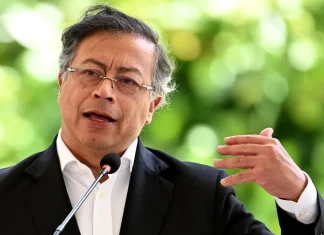Nov 03(Jowhar)-Madaxwaynaha Jamhuuriyadda Federaalka Soomaaliya Mudane Xasan Sheekh Maxamuud ayaa maanta magaalada Dodoma ee caasamidda dalka Tanzaniya uga qaybgalay caleema-saarka Madaxwaynaha dib loo doortay ee dalkaasi, Marwo Samia Suluhu Hassan.
Daniel Day-Lewis says method acting has been unfairly misrepresented
Why Daniel Day‑Lewis Is Done with the “Method Actor” Myth
There is a particular kind of hush that falls over a film set when Daniel Day‑Lewis walks on. It is the hush of respect — and, later, of stories that grow taller with each retelling. For decades, the actor’s name has been shorthand for devotion: for living in tents on oil fields, for days spent in prison cells, for an entire life rearranged on the altar of a single role.
But in a recent conversation with The Big Issue, Day‑Lewis, 68, cut through the gossip with a quiet, incandescent anger. “I just don’t like it being misrepresented to the extent it has been,” he said, exasperated by what he called the lumping of his craft into a caricature of “lunacy.”
The headlines versus the intention
It’s easy to see how the myth took hold. The stories are cinematic: a man in a teepee on a deserted Texan oil field while making There Will Be Blood (2007), nights in a cell without food or water to inhabit Gerry Conlon for In the Name of the Father (1993). Those anecdotes stick because they glitter. But Day‑Lewis insists the glitter is the problem. “They focus on ‘oh, he lived in a jail cell for six months’… Those are the least important details,” he said. The thing that matters, he argues, is the intention: to offer colleagues “a living, breathing human being they can interact with.”
He isn’t apologizing for intensity. He’s objecting to reduction. “In all the performing arts, people find their methods as a means to an end,” he told The Big Issue, blunt and precise. “So it p***es me off this whole ‘Oh, he went full method’ thing. What the f***, you know?”
Between craft and caricature
What Day‑Lewis is railing against is a cultural shorthand that strips nuance from creative labor. Method acting — loosely traced back to Stanislavski’s system and popularized in America by Lee Strasberg and others — is a toolbox, not a prescription for self‑destruction. For some actors it’s a private rehearsal ritual, for others a public vow. But the breathless coverage often reduces it to spectacle.
“We’ve turned devotion into a horror film,” said Maria Lopez, an acting coach who’s worked in London and Madrid for twenty years. “It’s as if staying in character equals heroism or danger. That’s a fantasy. The real work is about listening, connection, impulse, and generosity.”
Across the pond, a film student in Dublin named Aiden Murphy told me he grew up on the legends: “I thought it was about endurance records—who could suffer the longest,” he laughed. “Then I watched Day‑Lewis in Lincoln and realized it wasn’t about proving anything. It was about being utterly there.”
When disciples become headlines
The Day‑Lewis aura has its ripple effects. In 2023, Succession actor Brian Cox publicly criticized Jeremy Strong’s approach to method acting, quipping that Strong was “Dan Day‑Lewis’ assistant.” The barb landed widely, and Day‑Lewis found himself linked, undeservingly, to debates about on‑set behavior and extreme immersion.
“If I thought during our work together I’d interfered with his working process, I’d be appalled,” Day‑Lewis told The Big Issue, pushing back on the implication that his methods propagated bad practice. “I don’t feel responsible in any way for that.”
The human cost and the larger conversation
As audiences, we like narratives about the artist as martyr. They fit neatly into our hunger for Shakespearean extremes: the genius who burns for their art. But there are costs to that framing. It can normalize risky behavior, obscure consent and boundaries on set, and erase the critical element Day‑Lewis emphasizes — responsibility to one’s colleagues and the work.
“Acting is not solitary heroism,” said Dr. Lena Roth, a film historian in Berlin. “It’s a relational craft. The best performers I study are generous. They offer a ground for others to react to. That’s the opposite of the myth that method equals madness.”
Statistics on how many professional actors employ method techniques vary widely; there’s no universal checklist. But industry surveys and conservatory curricula suggest a plurality of methods are in play — voice work, movement, textual analysis, improvisation, and yes, various forms of immersive preparation. The point is not which technique is ‘real’ — it’s that the diversity of approaches resists reduction to a single headline.
Why this matters beyond movie trivia
Think for a moment about broader cultural patterns: the clickbait of the 24‑hour news cycle, the appetite for scandal, and our tendency to elevate extremes. Combine those with celebrity culture and you have the perfect engine for a myth to accelerate. But myths have consequences. They shape how we teach, how productions manage safety and consent, and how young practitioners imagine their path.
“There’s a moral I see emerging,” Lopez said. “We need to teach craft with ethics. How far you go should be negotiated, consensual, and reversible. That’s what keeps an industry healthy.”
Back in the room — the work that lasted
Daniel Day‑Lewis’s cv is spectacular not only for the intensity of his approach but for its results: three Academy Awards for Best Actor (1990 for My Left Foot, 2008 for There Will Be Blood and 2013 for Lincoln), making him the only man to win three Best Actor Oscars — a record he shares in spirit with very few names in acting lore.
He stunned audiences with Christy Brown’s fragile triumphs in My Left Foot, sculpted a terrifying portrait of capitalism in There Will Be Blood, and exuded quiet moral weight in Spielberg’s Lincoln. And yet, after a brief retirement announced — and later described by Day‑Lewis as “ill‑advised” — he returned last year to star in Anemone, a psychological drama directed by his son Ronan. The move reminded people that art can be a conversation across generations, not just a solitary rite.
What should we take away?
So what are we to believe when headlines tell us an actor “went full method”? Perhaps the better question is: what do we want to believe about the nature of art? Do we prefer gladiatorial endurance, or the quieter, tougher work of listening and giving space?
Day‑Lewis’s frustration is a useful prod. It asks us to slow down, to read past the anecdote, and to consider the ethics and craft behind a performance. It asks us to honor the labor without fetishizing the pain.
“I choose to stay and splash around, rather than jump in and out or play practical jokes with whoopee cushions between takes,” he told The Big Issue, offering an oddly charming image of how he prefers to inhabit a role. “It’s with the intention of freeing yourself so you present your colleagues with a living, breathing human being they can interact with. It’s very simple.”
Simple, perhaps — but not simple-minded. As consumers of culture, we can demand nuance. We can celebrate dedication without glamorizing harm. We can admire Day‑Lewis for his craft without mistaking method for madness.
What kind of stories about art do you want fed to the next generation — the mythic or the humane? The choice shapes what the stage, the set, and the culture will look like tomorrow.
Supreme Court to hear challenge to U.S. president’s tariff measures

In the Halls of Power: A Courtroom Fight That Could Redraw the Map of Global Trade
The marble of the Supreme Court seems colder in autumn. It holds light differently, catching the weight of decisions that ripple far beyond the city streets of Washington — into factories in the Midwest, into ports on the Pacific, and into family kitchens where the price of everyday goods is quietly tallied.
At its center now is a question that reads simple on paper and vast in consequence: can a president, invoking emergency economic powers, layer sweeping tariffs on imports from around the world? Or did those powers cross a line written to keep such sweeping economic change in the hands of Congress?
From White House edicts to the bench
The tariffs were rolled out quickly and with a flourish that matched the administration’s rhetoric. They were billed as “reciprocal” — a tit-for-tat measure meant to punish trading partners deemed to be undermining American industry and to coax better deals from negotiating tables. They targeted the nation’s largest trading partners and, in some cases, broad categories of imports from numerous countries.
But speed invites scrutiny. Legal challenges followed in short order. A lower court in May found the measures overstepped executive authority, a judgment that sent tremors through Washington and trading floors at once. The administration appealed and won a temporary stay that kept the levies in place while the case climbed the judicial ladder. Then, in August, the Court of Appeals for the Federal Circuit issued a 7–4 ruling echoing the lower court: the duties were illegal. That set the stage for the highest tribunal in the land to weigh in.
Why the case matters — beyond lawyers and law books
At stake is more than legal doctrine. The Supreme Court’s decision, whenever it lands, will determine who gets to steer the ship of U.S. trade policy in times of perceived economic emergency.
- Billions of dollars in customs revenue — already collected under the contested tariffs — hang in the balance.
- The ruling could either curtail or empower a president’s ability to use tariffs as bargaining chips in negotiations, shaping everything from bilateral deals to global supply chains.
- And it will send a signal to foreign governments and multinational corporations about whether Washington will wield unilateral economic tools as a routine instrument of statecraft.
“This isn’t just a legal tussle,” said Miriam Alvarez, a trade lawyer in San Diego. “It’s about who decides the rules for our economy: Congress, representing the people, or a single executive. If the Court blesses broad emergency tariffs, we could see a new normal in trade policymaking.”
Voices from the ground — factories, fields, and shopfronts
Walk past the docks of Long Beach on a grey morning and you can hear how the argument plays out in ordinary lives. Containers bubble with goods headed to shelf and assembly line alike. Importers watch customs notices like weather reports.
“Our margins are already thin,” said Asha Patel, who runs an electronics distribution company. “A sudden tariff can be the difference between running payroll and shutting a warehouse. We don’t have months to adapt. Supply chains move on weeks, not Twitter threads.”
In the Rust Belt, where the political rhetoric that birthed these measures has deep roots, the mood is not uniform. At a diner outside Cleveland, a line cook named Ben shrugged and said, “If it helps bring work back, I’ll take higher prices for a while.” But across town, a small auto-parts supplier fretted: “We rely on microchips and metal parts that come from abroad. Tariffs can break these fragile links.” The tension is emblematic — protection for some may be disruption for others.
What the judges are weighing
Constitutional scholars point to a knot of competing principles. On one side is the need for executive agility in economic emergencies — a capacity to act quickly when national industries are threatened. On the other is a constitutional design that reserves broad legislative authority for Congress, whose power to levy tariffs and regulate commerce is explicit.
“Courts have historically been wary of delegations of core policy power without clear congressional guidance,” explained Professor Daniel Kim, a constitutional law expert. “The question here is whether statutes that allow emergency tariffs were meant to permit the sweeping measures we saw, or whether they required a narrower, more defined exercise of power.”
The Supreme Court’s conservative majority adds another layer of uncertainty. Some justices are often skeptical of expansive federal power, but others value executive flexibility in national security and economic matters. The balance — and the written opinions that accompany the decision — will be dissected by policymakers and markets alike.
Wider ripples: geopolitics, supply chains and the global economy
Imagine a domino falling in Shanghai and landing in Stuttgart. Tariffs, by their nature, cross borders. Global value chains, already reshaped in the past decade by technology, pandemics and geopolitics, could be nudged again by the Court’s ruling.
Trade flows are enormous. The United States imports and exports goods and services worth trillions annually. Even a small change to policy can shift investment decisions, reroute manufacturing, and affect consumers’ wallets. Economists warn that tariff volatility can disincentivize long-term investments and encourage firms to hold more inventory — a cost passed to consumers.
“Companies plan on predictability,” said Linh Nguyen, a supply-chain analyst. “Unexpected tariffs create a tax on planning and on international cooperation. If the Court validates sweeping emergency tariffs, companies will have to factor that political risk into every cross-border contract.”
What outcomes are possible?
- The Court could rule the tariffs illegal, effectively aligning with the lower courts and curtailing the executive’s latitude.
- It could uphold the president’s actions, giving future administrations broader authority to impose similar levies.
- Or it could craft a middle-ground ruling, limiting the scope of emergency tariffs while preserving certain narrow authorities.
Each outcome carries economic and political currents. If the Court strikes the levies down, affected countries and firms may push for compensation or renegotiation. If the levies stand, expect new strategies: suppliers moving operations, trade partners retaliating, or businesses recalculating cost structures.
Questions to sit with
As a global audience, ask yourself: who should hold the economic levers in an interconnected era? Do crises justify extraordinary presidential power, or do they demand more democratic oversight? How do we balance the desire to protect industries with the need to keep markets stable and predictable?
Ultimately, this case is less about one president and more about the architecture of power in a world where economic levers can be as consequential as military ones. The Supreme Court will not just decide on a set of tariffs. It will help draw the boundary lines of American economic governance for years to come.
“We’re watching a constitutional tectonic shift,” said Professor Kim. “The aftershocks will be felt where people buy goods, where factories decide to build, and where governments negotiate.”
Whatever the Court decides, the effects will be lived in small and large ways — in the diner on a cold morning, in a port unloading a container, in the ledger of a midwest manufacturer. And in those everyday spaces, the abstract contours of power become sharply, personally real.
Air India crash survivor says “I’m alive” — calls escape a “miracle”
Alive but shattered: the sole survivor of Ahmedabad’s Air India crash speaks of loss, flashbacks and a family unravelled
When I met Vishwash Kumar Ramesh, he wore a New York Yankees cap tilted low, the brim shading eyes that had learned how to look and not be looked at. It was an ordinary American baseball cap, except that it had become, in the months since a June morning uprooted everything, a talisman of sorrow — his brother Ajay had worn the same hat on the doomed flight that killed 241 people. For Vishwash, the cap is more than cloth. It is a small, stubborn way to keep his brother close.
“God gave me life but took all my happiness,” he told me, voice thin and steady as if he had practised how to say unbearable things out loud. “I survived — that, yes, is a miracle. But my life, our life… my family has been completely brought down.”
A city scarred, a family undone
The crash of Air India flight AI171 — a Boeing 787 Dreamliner — on 12 June near Ahmedabad Airport has become a wound felt across continents. Of the 241 people on board, only Vishwash survived. The death toll included 169 Indian passengers and 52 British nationals, making this tragedy one of the deadliest ever in terms of British lives lost. Nineteen people on the ground also perished and 67 suffered serious injuries.
- Date: 12 June
- Flight: Air India AI171, Boeing 787 Dreamliner
- On-board fatalities: 241 (169 Indian, 52 British)
- On-ground fatalities: 19
- Serious injuries on ground: 67
Ahmedabad’s skyline — a city famed for its textile history, intricately carved pols and the warm, spiced aroma of street-side snacks — now holds a scar: a medical college where the aircraft came down. Locals still point, not with the curiosity of long-ago tragedies but with the slow, stunned gestures of people who carry knowledge that time cannot easily un-write.
“I get flashbacks all the time”
Trauma has a grammar of its own. For Vishwash it is sleeplessness — three or four hours a night — and a replay that will not be shut off. “I stay awake, sitting alone in my room,” he said. “I don’t talk much. I just sit on my bed and think.”
He has not, his advisers tell me, been able to speak in any depth with close family about the crash. Even among those who have gathered round — an extended web of uncles, cousins and close friends — the grief is so large it changes how people breathe. “My mother, father and younger brother totally broke down,” he said, voice cracking on the last word. “Every day I’m struggling.”
Vishwash’s advisers, Sanjiv Patel and Radd Seiger, have been vocal about how the survivor has been treated in the months since. “At times it feels like he’s been reduced to a file,” Patel said. “There’s grief you can measure in condolence letters and there’s grief that needs human hands. We’re not seeing enough of the latter.”
Paper promises, human consequences
Air India and its parent, the Tata Group, insist that care for survivors and families remains a priority. An interim payment has been transferred to Vishwash, and airline spokespeople say senior leaders have visited families and offered to meet with representatives. “We remain deeply conscious of our responsibility,” a company statement read, noting that compassion and support for all affected was ongoing.
Yet the feeling on the ground — in Leicester, where a significant Gujarati diaspora gathers, and in Ahmedabad, where relatives still mark the days that will not be forgotten — is of promises that have run out of elasticity. “We are sitting next to the sole survivor of this major airline crash, and as far as I can make out, he is being treated like a number on a spreadsheet,” Seiger told me. “You get one chance after a disaster to do the right thing. It’s not too late, but time is not infinite.”
Questions about why it happened
Official investigators in India’s Aircraft Accident Investigation Bureau produced a preliminary report noting that both fuel control switches moved to the “cut-off” position immediately after take-off, stopping fuel supply to the engine. That fact — stark and technical — has prompted urgent and painful questions about whether the crash could have been deliberate.
“When mechanical actions occur that lead to catastrophic outcomes, investigators have to consider every angle, including human factors,” said Dr. Kavita Sharma, an aviation safety expert who consults with international regulators. “But technical clues need to be handled slowly and with rigor. People’s lives depend on getting it right.”
Small details: a hat, a name, a memory
The cap Vishwash wears is small consolation, but it is emblematic of how families try to stitch together continuity when the tapestry has been torn. In Leicester, friends set up an informal support group, sharing meals and sitting with Vishwash when the nights get long. A community prayer was held in a small hall; bowls of khichdi and cups of sweet chai were offered to visitors, gestures that say, in Gujarati, you are not alone.
“In our culture we mourn together,” said Meena Desai, a family friend who helped organise support. “We hold hands. When that doesn’t happen properly — when institutions don’t reach — people feel abandoned.”
Why should you care? Why should this matter beyond Ahmedabad and Leicester?
Because this tragedy sits at the intersection of issues that touch many readers: the global movement of people and the fragile threads that tie diasporas to their homelands; corporate accountability when disasters strike; the mental health fallout that lingers long after headline cycles move on; and the painstaking, sometimes agonising work of figuring out how and why an aircraft — a modern miracle of engineering — came down.
And because grief like Vishwash’s does not respect borders. The dead included scores of British nationals; the survivor lives in the UK; the crash occurred in India. In an increasingly interconnected world, disasters ripple outward quickly — in bank transfers delayed or made, in calls unanswered, in meetings postponed and apologies that arrive too late.
What now?
Investigators will continue their work. Legal claims, compensation negotiations and community support will proceed in fits and starts. But for now, the immediate task is human: to listen better, to sit with survivors and families, and to treat people not as dossiers but as people who need presence, not only papers.
“He survived,” Patel said, looking directly at me. “But surviving is not the end of the story. What happens next — how we walk with him through this — will show us who we are.”
So I ask you, reader: if a friend or neighbour came to you carrying a grief so vast it had no roof to shelter it, what would you do? Hold them close? Offer coffee? Insist the authorities do better? The answers we give, individually and collectively, will shape the contours of recovery — long after investigations close and headlines fade.
RW Xamze oo amar dul-dhigay madaxda hay’ada NIRA
Nov 03(Jowhar)-Ra’iisul Wasaaraha Xukuumadda Jamhuuriyadda Federaalka Soomaaliya Mudane Xamze Cabdi Barre ayaa Kormeer degdeg ah ku tagay mid ka mid ah Xarumaha laga bixiyo Kaarka aqoonsiga Qaranka {NIRA} oo ku taala degmada Hodan ee gobolka Banaadir, isagoo faray madaxda hay’adda in dadka loo fududeeyo bixinta adeegga.
Trump leaves door open to U.S. military operation in Nigeria

“Could be”: The Words That Could Change a Nation
It was a dry, clipped exchange above the Atlantic — not a speech from a podium but a casual answer to a shouted question aboard Air Force One. “Could be,” President Donald Trump said when asked whether the United States might put boots on the ground in Nigeria or carry out air strikes. The sentence landed like a detonator in a theater already full of combustible fuel: a nation wrestling with persistent violence, a president stoking outrage on social media, and a world watching how rhetoric becomes policy.
Moments later, Mr. Trump amplified his message on Truth Social, saying he had asked the Pentagon to draw up “a plan of attack” as he warned that Christianity in Nigeria was under “existential” threat. That rapid-fire mix of on-the-record remarks and social-media theater has set off a scramble of diplomacy, denials and fear from Abuja to Lagos to villages in the Nigerian Middle Belt where communities live with daily uncertainty.
On the Ground: Lives Between Headlines
Walk through any market in Jos, the capital of Plateau State, and you’ll hear the soft, ordinary conversations of survival — the bargaining for pepper, the rattle of motorcycles, children skipping rope under the shade of tamarind trees. Yet beneath that normalcy is a long, bruising history of clashes: Boko Haram in the northeast, an insurgency that has stalked communities for more than a decade; armed herders and farmers clashing across the Middle Belt over land and water; bandit gangs in the northwest; and local militias carving out zones of control.
“We bury our dead more often now than we have weddings,” said a pastor in a small village outside Jos, speaking on the condition that his real name not be used. “When a stranger comes, my wife locks the door and counts the children twice. We are tired.”
Across town, Fatima—a shopkeeper who wears a bright hijab and sells beads and fabric—shook her head. “It is not only people of one faith who die,” she said. “We have friends and family on both sides. Our sorrow is shared. When the militias come, they do not ask who prays where.”
Numbers and Nuance
Nigeria is Africa’s most populous country, home to roughly 220 million people, with a religious landscape that is often described in broad strokes: predominantly Muslim in the north and predominantly Christian in the south, with countless communities and beliefs woven in between. But to reduce the violence to a single fault line is to miss the complexities of land use, climate pressures, weak state institutions, and criminal economies that sustain violence.
Decades of conflict have taken a heavy toll. Tens of thousands have been killed in the insurgencies and communal fights since the Boko Haram uprising began, while millions have been displaced within the country. Schools remain closed in some parts of the northeast. Farmlands lie fallow. Economic opportunities vanish. The social fabric wears thin.
Diplomacy, Denial, and the Language of Threat
Abuja’s response to the US rhetoric was carefully measured. Daniel Bwala, a spokesman for President Bola Ahmed Tinubu, suggested that a meeting between the two leaders could “iron out a common front” to tackle insecurity, and he welcomed support that respects Nigeria’s territorial integrity. “We are partners in the global fight against terrorism,” he told reporters, adding: “We do not read every social media post in the literal sense. Leaders talk. Then leaders meet.”
For many in Nigeria, the threat of foreign military intervention brings a cocktail of emotions: relief at the prospect of stopping killings; anger at what some perceive as an internationalization of a domestic crisis; and anxiety about sovereignty and the lessons of past interventions.
“History shows that foreign boots do not always deliver peace,” said Amina Ibrahim, a political scientist at a university in Abuja. “External military action can create space for state-building — or it can deepen grievance if not carefully coordinated. The United States has capabilities; but it must pair any operational support with long-term investments in governance, justice, and reconciliation.”
Voices from Washington and Beyond
In Washington, commentators framed Mr. Trump’s remarks as a blend of humanitarian concern and campaign punctuation. “This is presidential rhetoric that doubles as political theater,” said Marcus Bell, a foreign policy analyst who has tracked US engagement in West Africa. “Whether the White House has the appetite for a kinetic operation — with its legal, logistical and political complications — is another matter entirely.”
Humanitarian organizations warn that talk of strikes or foreign troops can worsen tensions on the ground. “When communities already fear being targeted, the presence of foreign forces or the threat of indiscriminate strikes risks escalating civilian harm,” said Sofia Mendes, a field director for an international aid group working in Nigeria. “Aid access is fragile. People flee. The most vulnerable pay the price.”
What Would Military Action Mean — and For Whom?
Military intervention is not merely a question of tactics. It forces us to reckon with deeper dilemmas: the line between protecting civilians and violating sovereignty; the sufficiency of military fixes for fundamentally political problems; and the risk that narratives of persecution—true and false—are leveraged to justify aggressive policies.
Ask yourself: do we want a world where the most powerful countries can unilaterally act on the basis of inflammatory social-media posts? Or do we want the painful, slow work of strengthening institutions that deliver justice and security for all citizens, regardless of faith?
Beyond the Headline: A Fragile Future
There is no neat answer. What is clear is that rhetoric changes realities. For families digging graves in the long shadow of violence, words from a distant leader can either spark hope or stoke fear. For diplomats, the current moment is an urgent test of whether international cooperation can translate into sustained, respectful action.
In villages and cities across Nigeria, people will continue waking early to tend goats, to cook, to pray and to protect their children. They will also be watching global leaders more closely than ever—counting promises, weighing motives, hoping for durable relief rather than a headline-making strike.
So what now? Will diplomacy follow the chatter? Will non-military avenues—economic aid, training for security forces, community reconciliation programs—get the resources they need? Or will the world learn once more the hard lesson that violence cannot be solved through a single campaign but through patient, often humbling statecraft?
As the sun sets over Lagos and the airlift hums in far-off skies, these questions hang in the warm dusk. They are not just Nigeria’s to answer; they are ours to witness and to weigh. If we care about justice, stability, and the dignity of ordinary lives, how will we choose to act?
Afghanistan earthquake leaves 20 dead, more than 300 injured
When the Earth Remembers: Mazar-i-Sharif After the 6.3 Quake
Night in Mazar-i-Sharif is usually the kind of slow, fragrant darkness that invites long cups of tea and the low chatter of old men on benches. On the night the ground woke, that hush was broken by a sound people compared to a distant train, then glass, then the groan of walls unmade.
At 6.3 magnitude and roughly 28 kilometres below the surface, the earthquake’s epicentre was traced near Mazar-i-Sharif by the US Geological Survey. By dawn, provincial health officials were reporting at least 20 dead and some 320 injured across Balkh and Samangan provinces, a preliminary tally that worried medics said would rise as rescuers reached remote hamlets.
The night the earth moved
“We were asleep. Suddenly the house was shaking like a leaf,” said Ahmad, a shopkeeper who lives close to the old bazaar, cradling a blanket against the morning chill. “My children were screaming. We ran into the street. People were holding candles and shouting the names of their neighbours.”
In cities and villages across northern Afghanistan, people poured into the open under a sky nervy with stars. Even in Kabul — some 420 kilometres away — correspondents felt the tremor. For many, the instinctive move was to the streets and courtyards, away from mudbrick walls that have stood for generations but were built for customs and warmth, not seismic resilience.
Blue tiles, broken pieces
The city’s famed Blue Mosque — a 15th-century jewel of turquoise tiles and towering minarets — bears the visible memory of the quake. Photographs and on-the-ground reports showed fragments of tile and masonry from one of its minarets strewn across the courtyard. For locals, the mosque is more than architecture; it is the city’s heart and an anchor for pilgrims and rare visitors.
“Seeing those tiles on the ground felt like seeing a piece of our history fall,” said Farah Naz, a schoolteacher who lives nearby. “You can fix stones, but you can’t stitch feelings as easily.”
On the map of risk: why Afghanistan trembles
Afghanistan sits along a jagged seam in the earth where the Eurasian and Indian tectonic plates meet, a region of frequent tremors, particularly along the Hindu Kush range. Earthquakes are not a novelty here; they are a recurring hazard in a landscape already worn thin by decades of conflict, drought, and economic strain.
In the past three years alone, the country has been battered by several lethal quakes: a shallow magnitude-6.0 tremor in August that devastated eastern villages, killing more than 2,200 people; significant shocks in Herat in 2023; and in Nangarhar in 2022 that flattened homes and lives alike. Each time, the pattern repeats: fragile housing stock, steep and remote roads, and communities cut off from immediate help.
Pockets of vulnerability
Most Afghans live in rural areas where homes are built of sun-baked bricks, stone, and mud — materials that keep heat and cold at bay but do little against a violent jolt. “You build what you know with the means you have,” explained Dr. Leyla Shirzada, a civil engineer who has worked on rural reconstruction projects. “Without training, funds, or building codes enforced, resilience becomes a luxury, not a standard.”
Poor communications amplify the danger. Mountainous terrain and aging infrastructure turn an emergency into a long wait. In past disasters, it has taken hours — and sometimes days — for authorities and aid agencies to reach cut-off villages. The result: delayed medical care, slower searches for survivors, and prolonged exposure for those who have lost shelter.
An unraveling safety net
The quake lands on an Afghanistan already strained by a humanitarian crisis. The Taliban administration, in power since 2021, is confronting its third major deadly earthquake during its rule even as international aid — once a lifeline for much of the country’s services — has declined dramatically. The United Nations and humanitarian groups have warned of rising hunger, and millions have been displaced or pushed back from neighbouring countries, putting more people in precarious conditions.
“If you compound natural hazards with economic restrictions, banking paralysis, and drought, you have a catastrophe that keeps renewing itself,” said Martina Kline, a regional analyst with an international aid agency. “The physical shaking is only part of the story. The rest is institutional fragility.”
Beyond the numbers are everyday tragedies: families who lose a breadwinner, a child’s schoolroom turned to rubble, a market stall where a livelihood once hummed now down to splinters. Those losses ripple across communities where social networks are the safety net and are already stretched thin.
Fast facts: the quake at a glance
- Magnitude: 6.3
- Depth: ~28 km
- Epicentre: Near Mazar-i-Sharif, northern Afghanistan
- Preliminary casualties: 20 dead, ~320 injured (Balkh and Samangan provinces)
- Distance to Kabul: ~420 km
Voices from the rubble
“We are hungry and now homeless,” said a woman who gave her name as Habiba, picking through the remnants of her home with slow, precise movements. “We don’t know where to go. The government says help is coming, but we have been waiting before.”
An official health ministry spokesman urged calm and patience, reminding people that assessing the full scale of damage takes time because of the country’s geography. “Our teams are mobilising; we will prioritise the most affected areas,” he told journalists. Yet for many in remote valleys, the arrival of aid depends on weather, road access, and the thin capacity of local responders.
What must change — and what can be done
Long after the headlines fade, reconstruction will demand more than bricks. Experts point to several urgent priorities:
- Investing in seismic-resistant building techniques scaled to local materials and budgets.
- Strengthening early-warning and communications systems to reach rural communities faster.
- Supporting local first responders and training community-based search-and-rescue teams.
- Restoring and expanding humanitarian assistance with clear, accountable channels to reach the most vulnerable.
“You can’t buy resilience overnight,” Dr. Shirzada said. “But you can start with training masons, distributing simple guidelines for safer construction, and investing in community-level preparedness. Small steps save lives.”
Why this matters to the world
Afghanistan’s quake is a reminder that natural hazards do not respect borders; their impacts are magnified by poverty, conflict, and policy choices. The international community faces a familiar test: whether to respond with resources that rebuild not just walls but systems, or whether to provide temporary fixes that leave vulnerabilities intact.
As you read this, ask yourself: when a place is broken by policy as much as by disaster, who bears the responsibility to repair it? What role should distant governments, aid groups, and private donors play in helping communities reimagine safer futures?
In Mazar-i-Sharif, among the shards of tile and the candles in courtyards, people are already answering in the old ways — neighbours moving in to share food, a mosque opening its doors, a teenager ferrying water to an injured neighbour. Those small acts — human, immediate, stubbornly kind — will be the first scaffolding of recovery.
The earth will move again. The question is whether the next time, fewer families will pay with their homes and lives. If we mean to learn, the work starts now, not in the news cycle, but in the training, the rebuilding, and the policy choices that follow.
NIRA oo war kasoo saartay Hooyooyin wadooyinka saq u dhexe u taagan kaarkooda
Nov 03(Jowhar)-Maareeyaha Hay’adda NIRA Cabdiweli Timacadde ayaa ka hadlay Muuqaalo iyo Sawirro qabsaday Baraha Bulshada kuwaasi oo muujinayey Haween iyo dad kale oo xilli habeen ah dhax jiifa mid ka mid ah wadooyinka Muqdisho si ay xilliga aroortii ah u helaan Kaarka hay’adda.
Askari Gorgor ah oo laba Nabad Sugida ka tiraan ku dilay magaalada Muqdisho
Nov 03(Jowhar)-Laba askri oo ka tirsan Nabad Sugida magaalada Muqdisho ayaa xalay lagu dilay degmada Garasbaaley ee dhacda duleedka caasimadda.
Irish couple stranded in Jamaica say “nobody is helping us”
Stranded in Paradise: Storm, Shortages and the Long Road Home After Hurricane Melissa
The buzz of reggae and the smell of salt and sun have been replaced by a different kind of soundtrack in Montego Bay: the rhythmic drip of rainwater, the distant hum of generators, and the low, urgent chatter of guests gathered beneath hotel awnings. For Lisa and Brendan Mooney, what was meant to be a dream 50th birthday escape has been folded into a waiting game — one measured in cancelled flights, dwindling supplies and the tiny, persistent worry that comes when you rely on a medical device far from home.
“We came for beaches and jerk chicken,” Lisa said, speaking through a cracked hotel phone as she sat on the edge of a towel-covered bed, “and now we’re queuing for bottled water like it’s the only thing that matters.” Her voice, at once tired and wry, carries a familiar human timbre: resigned, but not defeated. “They’re rationing pool water for flushing — two hours a night. I’ve had to mop the rain out of the room myself. I’m on an insulin pump. I need proper food and my medications. I need to be home for my kids.”
A storm of a scale not seen in decades
Locals and visitors alike are processing what meteorologists and government officials described as a historic blow. Melissa — which forecasters said was the most powerful storm to directly strike Jamaica in decades — carved a path of topsy-turvy roofs, flooded streets and damaged infrastructure. News outlets compared it to Hurricane Gilbert, the last major system to land-force Jamaica in 1988, and officials warned the island is only at the beginning of the recovery.
“We have never seen something hit like this in our memory,” said Marcia Thompson, a hotelfront desk manager who stayed through the worst of the winds. “People were scared. A lot of my colleagues lost their homes. We’re trying to help guests, but the staff here are hurting too.”
Jamaica’s tourism industry — which, depending on how you count direct and indirect activity, accounts for roughly a third of the island’s economy — now faces a twin crisis: caring for the thousands hurt and displaced, while also dealing with an immediate collapse in visitor infrastructure that sustains livelihoods across the island.
The human side of a travel nightmare
For the Mooneys, the practical obstacles have been relentless. Their holiday has been punctuated by cancelled flights — two already — and a third connection that, as of our conversation, was booked to New York, a gateway that might or might not fly depending on the broader recovery. “We are now booked on one to New York on Tuesday afternoon,” Lisa told me. “We are hoping against hope that it leaves.”
Beyond the logistics lies the emotional toll. The couple are parents of three back in Loughlinstown, Dublin. “I want to get home. I keep thinking about the kids and the routine that keeps our lives together,” Brendan added from his phone, the cracks of intermittent signal making him pause between words. “But I also think about the people here — the taxi drivers, the tour guides who make their lives from this. They need the tourists to return, but they also need time to heal.”
Local shopkeeper Alvin Grant summed it up on a humid, grey morning outside his shuttered storefront. “When the cruise ships stop, everything slows — the market, the eateries, the whole village. We depend on people coming here,” he said. “We’ll rebuild. But it’s hard when the money stops suddenly.”
Consular care, advice — and unequal responses
Back home, the Department of Foreign Affairs was quick to say it was aware of a small number of Irish citizens seeking to leave Jamaica and that consular officers were providing help and advice. The Irish Travel Agents Association urged travellers to monitor local updates, to keep their phones charged and to contact their tour operators for support.
“We’re in contact with Irish nationals in the area and are providing advice on safe travel home,” said a spokesman for the Department. “Our teams are coordinating with airlines where possible, but flight schedules are dependent on local recovery and airport capabilities.”
Not everyone feels the response has matched the need. “England and Canada have put on flights to take their citizens home,” Lisa said. “We feel a bit left on our own.” Whether or not that perception is a reflection of diplomatic choices, it underscores a bitter truth about emergencies: repatriation capacity is unequal, and the politics of evacuation can leave people feeling exposed.
Why storms like Melissa are getting tougher to predict — and more destructive
Experts say Melissa’s ferocity is not an isolated curiosity but part of a broader pattern. “Warmer oceans and shifts in atmospheric patterns are making the strongest storms stronger and sometimes faster,” said Dr. Ana Clarke, a climate researcher at the University of the West Indies. “We’re seeing more intense rainfall and more rapid intensification of tropical cyclones in the tropics. That increases the risk to islands like Jamaica that have limited buffer zones.”
Global climate assessments have found that while the total number of tropical cyclones may not be increasing dramatically, the proportion of the most intense storms — Categories 4 and 5 — has risen in recent decades. For island nations, this means that rare events can become suddenly more perilous.
Small comforts, big questions
Across Jamaica, the response has become a mix of improvisation and resilience. Church halls have turned into shelters. A local bakery in Montego Bay opened early to hand out bread. Volunteer crews from neighbouring parishes drove through mud and detritus to help clear roads.
“We’re doing what we can,” said Reverend Dwight Palmer, who coordinated a local relief point. “We’re offering shelters, meals, and a listening ear. But this is a big storm. The reality is resources will be stretched for weeks.”
For tourists stranded in the aftermath, small acts matter. “A woman from a nearby guesthouse handed me a cup of stew when she heard I had children waiting at home,” Lisa remembered. “It was just kindness. That’s what keeps you going.”
Practical notes for travellers — and a moment to reflect
If you are traveling or planning to, consider these practical steps to reduce risk and stay informed:
- Keep travel insurance up to date and read the emergency evacuation clauses carefully.
- Register with your embassy or foreign office so consular services can reach you quickly.
- Keep essential medications and supplies in carry-on luggage; carry a doctor’s note for devices like insulin pumps.
- Follow local authorities’ instructions and stay tuned to local news and official channels.
But beyond the checklist lies a larger conversation. What does it mean to travel in a warming world? How should governments, airlines and the tourism industry balance the economic lifeline visitors provide with the duty to protect both travellers and the communities they visit?
“We’d all rather be in the sand with a rum punch,” Brendan said, searching for a brighter note. “But when things go wrong, you see what matters: family, safety, and the kindness of strangers. I just want to be home — but I also hope Jamaica gets the help it needs to heal.”
As recovery unfolds, the world will be watching. Not simply because of tourists like the Mooneys, but because islands like Jamaica are early warning systems — a glimpse of how climate shocks can ripple through economies, families and daily life. How we respond now says something about our priorities. It asks us to consider: when travel returns, what kind of resilience should we demand for the places we love to visit?


